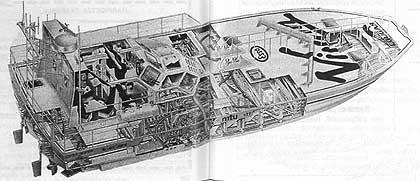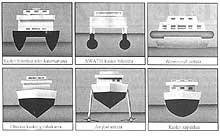History of Naval Construction (and XVI): Superfast Ships
Elhuyar Fundazioa
Throughout the time it has been detected the need to adapt the shapes of their helmets as the systems of propulsion in the ships are being modified. In the old planes, on the one hand, appear long boats of sharp branch that could be fast, but also of low stability. On the other hand, the transport boats were wide and robust. They had good stability, but could not get a great speed.
When calculating the speed of the boat, it has much to see the drawback of the water to the hull in its displacement. In order to study this obstacle or resistance, around 1775 the first test channel was built at the Paris Military School. In that channel a model of the ship was transported with a determined force and the speed was measured. The builders compared the speeds of the different models and believed that the ship that corresponded to the fastest model was also the fastest. They knew with experience that the long helmets were faster and the obese helmets were slower.
However, when they began to build fast boats, the plans for the models were not useful. In fact, friction in water has other factors at high speed: the waves generated by the interaction between the water and the hull and the trailers on the pop side. In boats with high power propulsion, in addition, these last factors can have a greater effect than the friction itself.
Taking into account the waves and turbulences generated, the designers began to decide the most suitable shapes for fast boats. David Taylor carried out systematic research in Washington in 1899 and determined the hydrodynamic resistance corresponding to each form. It must be recognized that at present the values of Taylor are still used for the design of the commercial ships.
Towards 1930, however, in the small ships began an authentic revolution, since it could take advantage of the propulsion of gasoline engines. Later, in the small boats, the engines were placed in the stern. In this way, small and fast boats of great power were achieved. But these boats were lifted up their bow and that, besides being closed, is dangerous.
The insecurity was solved with the introduction of more diving in the area of pop. In addition, thanks to the principle of Archimedes the upward force was greater and the performance of the propulsion also.
By 1960 the fast boats reached speeds of up to twenty knots. For example, the vedettes of Cherbourg, although at the quarantine they could reach that metro speed.
The Coast Guard police also needed fast boats for their work, which in France, for example, in 1975, were 13.3 meters long and 25 knots.
In the design of helmets, simulations are currently performed using computers. But this system is very expensive and is mainly used on large boats.
However, in the design of the helmets have also had a lot to see the recreational boats. The following figure shows the different shapes of helmets, and we consider it essential to talk about each of them.
The typical monolingual cap is suitable for situations in which good stability is desired at low and medium speeds, as in the case of oil tankers, but it is usually very resistant to water.
In the crushed hull, since the water resistance is less, higher speeds can be achieved. In return, stability is lower. This is usually the fast boats of the coast guard.
The double casquete or catamaran makes the boat very stable and suitable to move in shallow waters. On the other hand, since on both helmets can form a laun and wide platform, it is very suitable for the transport of containers, etc. However, at high speeds, water resistance is not low.
Another hull similar to Katamaran is that of the SWATH (Small Waterplane Area Twin Hull) boats. In them, on two large floats, a wide platform is out of the water. Its best behavior is at high speed and long trips.
The Jet-Foil is an ideal boat for high speeds. It is a basic helmet with two long arms. When the boat is standing the two arms are submerged and when the thrust of their propellers goes at full speed, the entire hull rises by decreasing friction with water.
In the so-called Hovercraft, fans create an air mattress between the boat and water (or land). Ideal for running with little friction in stagnant waters.







